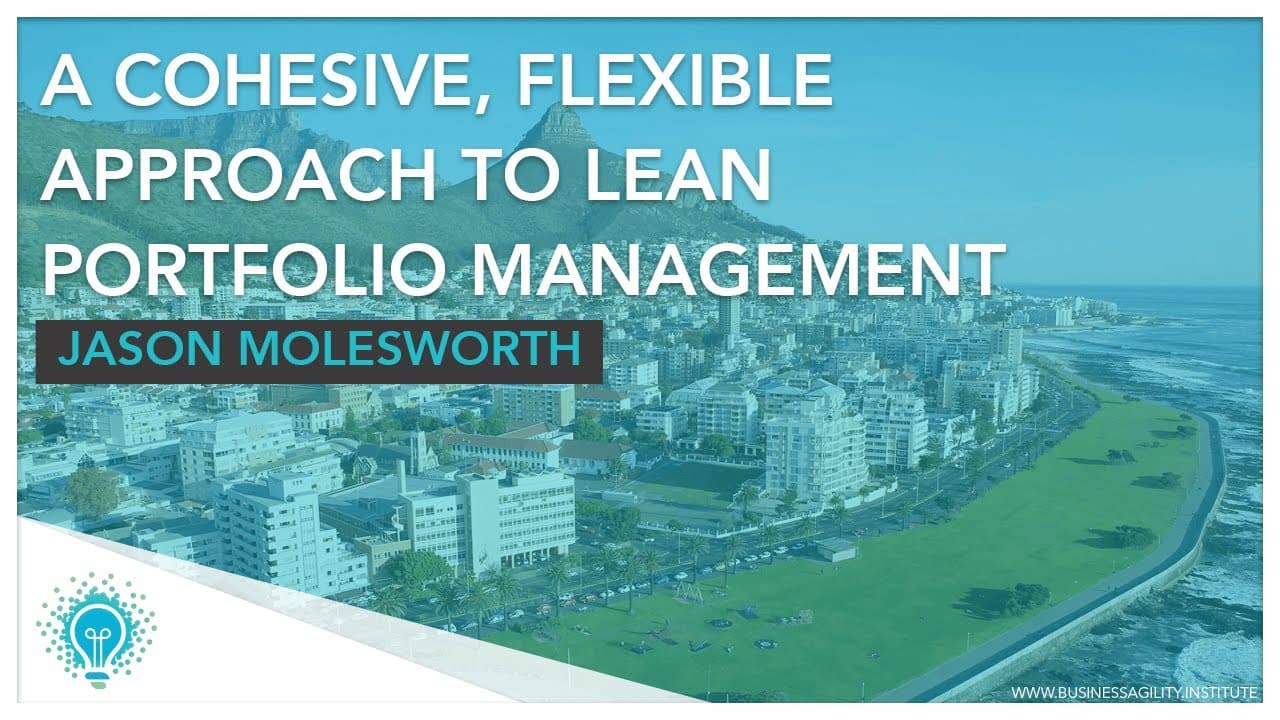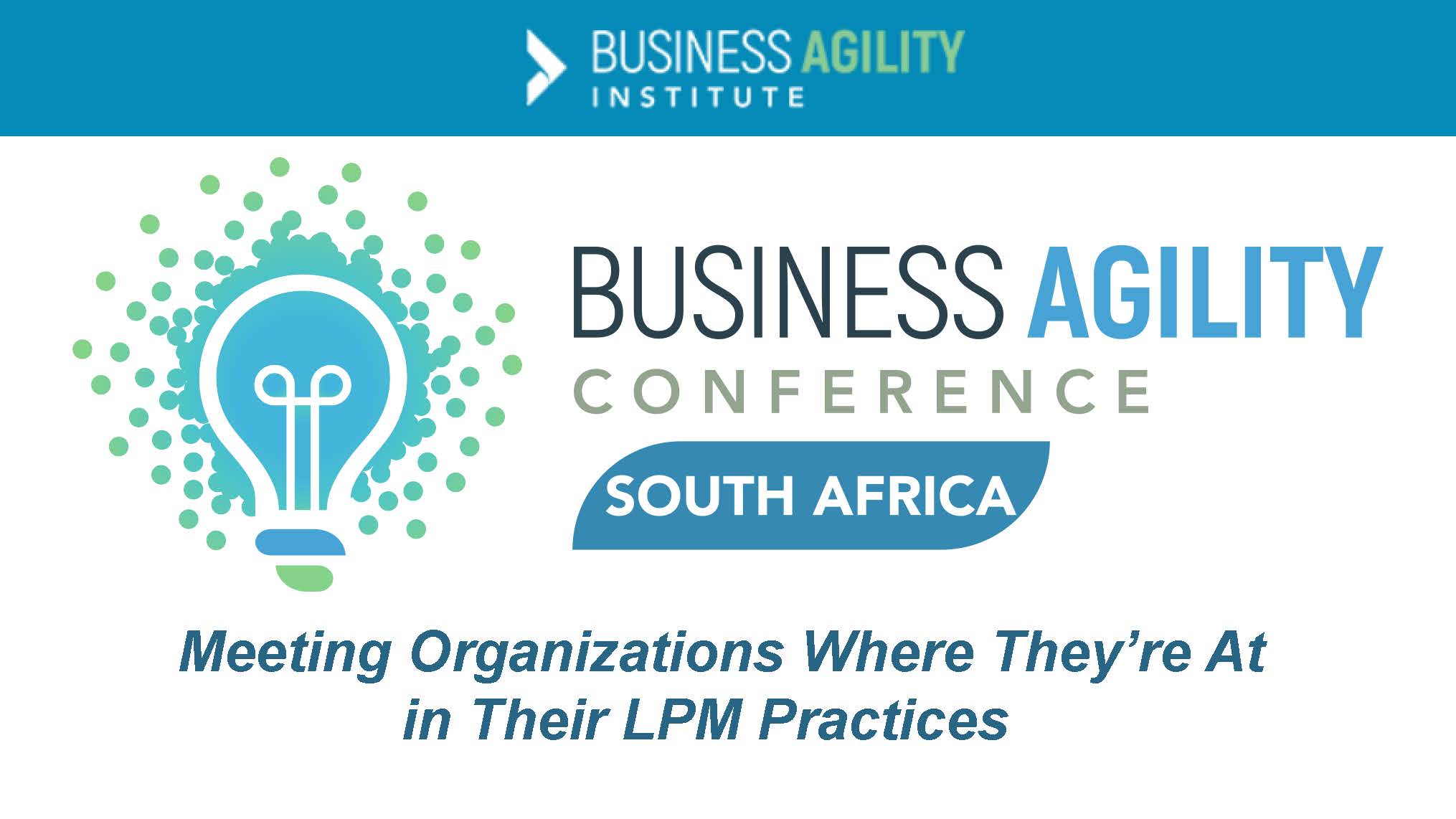All right, so I was looking forward to being introduced as the tall, decreasingly blonde member of the audience, but thank you very much for the kind introduction. I hope you guys are properly caffeinated. We're going to wrap this with two presentations—I'll be presenting, and then Stuart has an awesome presentation to cap the day.
I want to start by thanking the previous presenters. Let's get some feedback—has this been a pretty inspiring couple of days for you guys? Yeah? Yeah, it's been pretty awesome. And thank you to Myles and the whole committee for pulling this together. I have no doubt this is the first event of many, because I certainly have taken a tremendous amount away from it.
Five Goals for This Presentation
First, we want to talk about how we leverage Lean Portfolio Management (LPM) to:
- Clarify your strategy.
- Align your work to the key outcomes that matter.
- Get all your ducks in a row and build adaptability into your portfolio management practices.
Ultimately, we want the flexibility to enable the ultimate business goals we’re looking to drive. That means providing options and building modularity into your practice. There's nothing worse than engaging with a team and realizing you've only got one thing on the menu. Finally, we want to meet organizations where they are in their portfolio management practices.
How Do You Feel About Portfolio Management?
Before we dive in, I want to take a quick, informal poll. From an emotional perspective—yes, this is very touchy-feely—how do you feel when we talk about portfolio management practices?
- Are you super stoked? Is this an exciting topic?
- Are you thinking, "Oh no, not this stuff again?"
- Or maybe, "Holy cow, we need to figure this out now!"
Who's in the first group? A few of you—awesome. Who's in the second? Okay, I don’t see any hands. And how many of you are in the third? Ah, quite a few—yes, it’s one of the pressing problems in organizations today. Let’s dig in.
Reframing the Conversation
What if we reframed the conversation slightly and borrowed from another field? What if I could give you hints on how to optimize the impact of your personal investments—to provide better for your family, understand where your plan is working (or not), and maybe even fund your next big vacation?
When I think about portfolio management, I see surprising similarities with lean portfolio management. Both focus on maximizing the impact of investments while providing transparency and adaptability. The goal is clear—define your North Star, pursue it with transparency, and adapt rapidly when needed.
How LPM Helps Your Organization
LPM provides a ton of ways to:
- Define a clear North Star for your organization.
- Focus people on the business outcomes that matter.
- Make collaboration and delivery easier.
- Take care of our people and prevent burnout.
- Identify when we’re off track and pivot accordingly.
Key Takeaways for Lean Portfolio Management
1. Clear Strategy and Funding Alignment
As leaders, setting a clear North Star is on you. Your teams need clarity on where they’re headed, what customers need today, and where the organization is going tomorrow. The strategic intent must go beyond just "doing things"—we must clearly articulate why we’re doing them.
2. Customer Focus
Maniacally focus on delivering value to customers. Whether you're in retail, B2B, or internal services, the ultimate goal is to add value relentlessly. That’s what drives business success.
3. Empowering Teams
We define the "what" and measure success, but teams must own the "how." This is fundamental to agility—empowered teams deliver the best results.
4. Organizational Alignment
We often see good alignment at the team or portfolio level, but broader alignment across the organization is critical. If you see many horizontal dependencies, it’s a sign that your organizational structure may need rethinking.
5. Capacity and Demand Management
Organizations often believe they have more capacity than they do. If you assume 80% of your people’s time is available for transformation work, but in reality, it’s only 20%, you're setting them up for burnout. Understanding true capacity before assigning work is critical.
6. Value-Based Prioritization
Prioritization should be principle-based and transparent. It's not just about what gets done but also what gets deferred. There’s nothing worse than going through an extensive prioritization process only to have additional work arbitrarily added.
7. Quarterly Planning
Annual planning is painful. Many organizations are shifting to rolling quarterly planning because planning too far ahead is unrealistic. I can’t predict what I’ll be doing nine months from now, but I can plan for the next 90 days.
8. Transparency and Governance
Good governance doesn’t mean bureaucracy—it means setting clear boundaries so teams can operate autonomously. Leaders should be evaluated based on their ability to remove obstacles and create an environment for success.
Transforming the PMO
For many organizations, the PMO (Project Management Office) is a four-letter word. It’s often seen as bureaucratic and process-heavy. Instead, we should transition to Lean Portfolio Management (LPM) Groups that focus on:
- Delivering value.
- Challenging vision and intent.
- Enabling transparency and governance.
Lessons Learned
- LPM is hard but impactful. Portfolio management is complex, but getting it right is crucial for business agility.
- Find quick wins. Look for easy improvements to build momentum while planting seeds for bigger changes.
- Be flexible. Every organization is different. Adapt your approach to fit the culture and market.
- Meet organizations where they are. Many organizations have portfolio management fatigue—don't force change, but rather sense where energy exists and build from there.
Final Thoughts
In the last four days, I’ve had five companies reach out about portfolio management. They’ve been sitting with these concepts for months, and now they’re ready to act. One company running a billion-dollar transformation program asked, "How do we solve our reporting challenges?" The answer lies in applying lean principles to portfolio management.
So, whether you're in Chicago in February or San Antonio in the sunshine, the need for better portfolio management is the same. Thank you.





